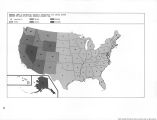| OCR Text |
Show (4) Conduct of public meetings to obtain citizen views on significant fish and wildlife actions contemplated for Federal lands within the state. The Definition of Management Goals Recommendation 62: The objectives to be served in the management of fish and resident wildlife resources, and providing for their use on all classes of Federal public lands, should be clearly defined by statute. The traditional jurisdiction of the states over the taking and transport of fish and wildlife, coupled with divided Congressional Committee jurisdiction referred to above, has resulted in the absence of Federal legislation enunciating wildlife management objectives for the public lands administered by the Forest Service and Bureau of Land Management for multiple use purposes. We believe this has at times heightened the disputes over jurisdiction between the states and Federal land administering agencies; and it has made Federal administrators reluctant to institute broader positive programs for fish and wildlife on public lands. Except for statutory recognition of fish and wildlife as a purpose of sustained yield management in the I9608 and 1964 multiple use acts,9 there is no statutory guidance as to the purposes to be served or how resources are to be allocated for fish and wildlife on the lands to which these acts apply. The Federal Government has a responsibility to make provision for protecting, maintaining, and enhancing fish and wildlife values on its lands generally because of the importance of those values as part of the natural environment, over and above their value for hunting, fishing, and other recreational purposes. Protection and propagation of rare and endangered species of wildlife should be given a preference over other uses of public lands. The Federal Government formally assumed a national responsibility for protecting rare or endangered species of native fish and wildlife in the Endangered Species Act of 1966.10 While this act was not designed primarily for the public lands, we believe its intent should be specifically adopted as one of the defined goals of public land management. Some areas of public lands have already been set aside to protect disappearing species, such as the California condor and the Kirtland warbler. Where certain areas of public lands are the only or best habitat of species that may be threatened with extinction, other uses of the land and resources should be foregone or restricted in the interest of protecting them. 8 16 U.S.C. §§ 528-531 (1964). 9 43 U.S.C. §§ 1411-1418 (1964), as amended, (Supp. IV, 1969). 10 16 U.S.C. §§ 668aa et seq. (Supp. V, 1970). 160 We believe that some provision should also be made to give recognition to species other than those considered to be "native". This would provide a statutory basis to afford appropriate protection and management for such animals as wild horses and burros and imported species such as pheasants. Following preference to rare and endangered species, preference should be given to the support of those species for which the public lands provide a critical or significant portion of the habitat. Public lands make up the principal habitat for a large proportion and, in some instances, nearly the entire population, of some species of wild animals and fish. As mentioned before, mountain goats and sheep, moose, elk, wild turkey, and caribou depend heavily on the public land habitat year-round. Some species use public lands for critical summer or winter feeding or nesting areas. The Commission believes preference should be afforded species in this category in allocating public land resources, and in considering the extent to which other uses should be permitted or constraints be imposed on them for the benefit of fish and wildlife. Game and nongame species of resident wildlife should be given equal attention in the administration of public lands. The Commission is concerned over the lack of attention given nongame species of wildlife in public land management generally, and in providing for public land use by people for purposes associated with the appreciation and enjoyment of such species. With few exceptions-and most of these have to do with nongame species considered to be in danger of extinction-the Federal land administering agencies devote relatively little resource management effort or attention to birds, mammals, and reptiles in this category. We believe the resulting imbalance in resource management policy must be redressed. Hunting, fishing, and other forms of use and enjoyment of resident wildlife and fish should be given equal consideration in Federal public land programs, along with other uses of the public lands. The United States should make its lands available to people for fish and wildlife use purposes under explicit management policies and programs with provision for protection of other uses. Fish and wildlife populations should be maintained at levels in consonance with the ability of the habitat to support them, including, where appropriate and necessary, stocking streams with fish. Public land vegetation should be managed so as to sustain wildlife population levels without artificial feeding, and, conversely, reduction programs must be instituted in case of overpopulation. These guidelines are essential for public land management programs in determining when wildlife populations are exceeding the carrying capacity of the land, and thereby encroaching on other values of the lands, and for allocating resources |







































































































































































































































































































































































